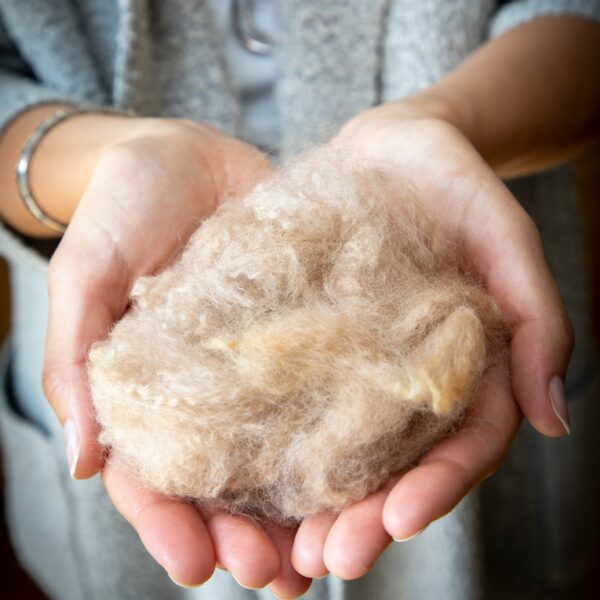What Spring Allergies and Your Bedroom Have in Common
We’re fully in the throes of Spring, and if all the chirping birds and blooming flowers remind you of itchy, watery eyes and a stuffy nose, then we’ve got some good news for you. While we can’t do much about the tree and grass pollen outside, allergy sufferers can find great relief with some thoughtful bedroom upgrades.
Here are several ways natural bedding can ease the sneeze.
Wool is Hypoallergenic
Did you know that dust mites are a major cause of indoor allergies and asthma? Dust mites thrive on the dead skin cells we shed and the humidity in the room, and unfortunately, the bedroom is a goldmine of a buffet for them.
Dust mite allergies range from mild to severe, and symptoms include:
- Sneezing and cough
- Runny nose, postnasal drip
- Itchy, red or watery eyes
- Nasal congestion, facial pressure or pain
- Itchy nose, roof of mouth or throat
- Swollen, dark under eye skin
If you experience asthma, you may also have:
- Difficulty breathing
- Chest tightness or pain
- Whistling or wheezing sounds
- Trouble sleeping caused by shortness of breath, coughing or wheezing
If your bedding items like pillows, mattresses, and comforters are older and synthetic, it’s probably time to consider replacing them.
Wool is a superior fiber for bedding for so many reasons, and another happens to be that it’s resistant to little buggers like dust mites and bed bugs. They prefer hot and humid environments, and wool prevents that with its temperature and moisture regulating qualities. (Learn more about hot and humid sleeping here.)
A Shepherd’s Dream wool mattress, wool pillow, wool comforter, and wool topper could go a long way toward helping you sleep easier and feel less sniffly during the day. Of special note for anyone who knows they’re sensitive to dust mites, check out our Wooly Down Pillow! Not only is it customizable for whatever sleeping position you prefer, the wooly clusters inside the pillow can be removed and washed with a wool-safe cleanser like Eucalan. (You can learn more about how to safely and effectively wash your woolen items here.)
Wool is Mold & Mildew Resistant
Indoors and outdoors, mold is another allergy trigger. And wouldn’t you know it—wool is naturally resistant to molds and mildew as well! Its moisture wicking capability and breathability help manage moisture so that the slimy stuff never has a chance to grow.
In addition, the structure of the wool fibers are rougher than smooth synthetics, so bacterial or microbial growths just aren’t attracted to wool’s surfaces.
Our Bedding is All Natural
The truth is that our indoor environments can be as much of an allergen as the great outdoors, especially for folks who find themselves sensitive to things like artificial fragrances, synthetic fabrics, chemical treatments, flame retardants, and harsh dyes. And for those who suffer seasonal allergies, it may not be immediately obvious that your home could be contributing to your symptoms. These invisible irritants can really begin to add up, which can exacerbate seasonal allergy issues.
Luckily, the wool, natural latex, and organic cotton materials we use in our products are all natural, nontoxic, and free of any chemical treatments or additives. It’s pure, and as direct and unadulterated from nature as possible. Aside from our own products, we absolutely love the Coyuchi linens we carry for carefree softness next to our skin.
Learn more about why indoor air quality is so important here.
Other Allergy-Relieving Options
IN THE HOME
In addition to allergen-proofing your bedding, here are some other ideas to help you breathe easier:
- Consider removing carpets in the bedroom for natural fiber rugs instead that can be cleaned and aired out easily.
- Be sure to routinely clean and air out upholstered furniture and drapes.
- Wash sheets and bedding in hot water.
- Use a dehumidifier and an air purifier with a good air filter.
- Make sure your vacuum has a HEPA filter on it.
- Clean surfaces that have a tendency to mold including air-conditioners, humidifiers, dehumidifiers, swamp coolers, and fridge drip pans.
- Keep doors and windows closed during pollen seasons.
SUPPLEMENTS
You may be already taking some of these. Be sure to check with your doctor first before adding in anything new to your existing medical regimens.
- Probiotics– Some studies have shown the probiotic L. Acidopholis to reduce allergic reactions to pollen.
- Quercetin– A flavonoid that may be able to stop and release the production of histamine. Studies are still needed. *Consult your physician if you are taking other medications.*
- Vitamin C (2000 mg/day)– Has some antihistamine properties.
- Spirulina– A type of blue-green algae (delicious in smoothies). Stops the release of histamines in test tube and animal testing.
- Omega-3 fatty acid– Studies have shown people with diets rich in Omega 3s have lower allergy symptoms.
- Vitamin D– Has been found to reduce allergic reactions to mold.
- Goldenseal– Studies show it may be helpful for relief of seasonal allergies.
HERBAL HELPERS
These work best when there’s a consistent supply in your body, so consider getting ahead of allergy season by at least two weeks. Look for teas, tinctures, or powders to add to smoothies.
- Butterbur (Petasites Hybridus)– A natural antihistamine. Do not use if you’re allergic to ragweed, marigold, daisy or chrysanthemum.
- Stinging Nettle (Urtica Dioica)– Another natural antihistamine, recommended dose is 300mg freeze dried per day.
- Astragalus (Astragalus Membraneceus)– Polysaccharides helped to reduce symptoms such as runny nose, itching & sneezing.
We hope this has been helpful for you and that you get the opportunity to enjoy all that Spring brings. Be sure to follow us on Instagram and check us out on Pinterest for more healthy living and sleep tips. And as always—sweet dreams!





